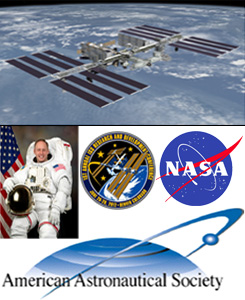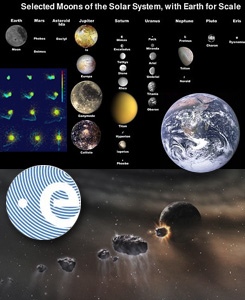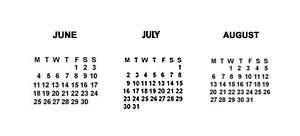American Astronautical Society Hosts 1st Annual ISS R&D Conference
 The American Astronautical Society along with NASA and the Center for Advancement of Science in Space are presenting the 1st Annual International Space Station (ISS) Research and Development Conference in Denver, Colorado from June 27 to 29. The conference will include parallel technical sessions and a separate workshop designed to update scientists on ISS research results and technological developments to explore how these accomplishments can be used to develop new ideas for experiments on the ISS. One of the highlights of the conference will be a luncheon on June 27 with guest speaker Astronaut E. Michael Fincke. Fincke was a crew member on ISS Expeditions 9 and 18 and flew on the final flight of Space Shuttle Endeavour. Top science and technology results will be presented from a wide range of studies, including microgravity research into the mechanisms and treatment of infectious diseases, novel fluid management systems aboard spacecraft and advanced diagnostic ultrasound in microgravity. Opportunities for exploration beyond Earth orbit include in-space robotic refueling and repair, optical communications, space-based, on-demand fabrication of metallic parts and environmental control and life support systems. (Image credit: NASA, AAS)
The American Astronautical Society along with NASA and the Center for Advancement of Science in Space are presenting the 1st Annual International Space Station (ISS) Research and Development Conference in Denver, Colorado from June 27 to 29. The conference will include parallel technical sessions and a separate workshop designed to update scientists on ISS research results and technological developments to explore how these accomplishments can be used to develop new ideas for experiments on the ISS. One of the highlights of the conference will be a luncheon on June 27 with guest speaker Astronaut E. Michael Fincke. Fincke was a crew member on ISS Expeditions 9 and 18 and flew on the final flight of Space Shuttle Endeavour. Top science and technology results will be presented from a wide range of studies, including microgravity research into the mechanisms and treatment of infectious diseases, novel fluid management systems aboard spacecraft and advanced diagnostic ultrasound in microgravity. Opportunities for exploration beyond Earth orbit include in-space robotic refueling and repair, optical communications, space-based, on-demand fabrication of metallic parts and environmental control and life support systems. (Image credit: NASA, AAS)
ESA Symposium in The Netherlands Featuring Moons

Formation and Evolution of Moons, an ESLAB Symposium, will be hosted by the European Space Agency and the European Space Research and Technology Center in Noordwijk, The Netherlands on June 25-28. Right now, including Luna, 170 known moons are in orbit around six of the eight planets and 7 known moons orbit three of the five dwarf planets. The primary goal of the symposium, namely understanding the formation and evolution of the natural satellites of the planets, is important to our wider understanding of the formation and evolution of the Solar System as a whole. There are 45 invited and contributed talks on: the Earth-Luna system, the natural satellites of the giant planets and of Pluto and dwarf planets, ring-moon interactions, Mars’ Phobos and Deimos, and the absence of moons around Mercury and Venus. The ESLAB is an annual meeting organized by the ESA Directorate of Science and Robotic Exploration Research and Scientific Support Department. Conference presentations will be posted on the web and a dedicated issue of an international peer-reviewed scientific journal is under consideration. (Image credit: ESA, NASA, Southwest Research Institute)

![]() = All times for terrestrial events in local time unless noted.
= All times for terrestrial events in local time unless noted.
![]() = All times for international terrestrial events in local time unless noted.
= All times for international terrestrial events in local time unless noted.
![]() = All times for space events, and…
= All times for space events, and…
![]() = All times for international space / astro events in Hawaii Standard Time unless noted. Add 10 hours to obtain UT (‘Universal Time;’ Greenwich, England).
= All times for international space / astro events in Hawaii Standard Time unless noted. Add 10 hours to obtain UT (‘Universal Time;’ Greenwich, England).
Weekly Planet Watch – Evening Planets: Mercury (WNW), Mars (SW), Saturn (SW). Morning Planets: Venus (ENE), Jupiter (ENE).
MONDAY
![]() Jun 25 — Shenzhou 9, LEO: Preparing to undock from Tiangong 1 so crew can demonstrate manually-controlled docking procedure.
Jun 25 — Shenzhou 9, LEO: Preparing to undock from Tiangong 1 so crew can demonstrate manually-controlled docking procedure.
![]() Jun 25 — International Space Station, LEO: Expedition 31 crew is continuing robotics test of remotely operated satellite refueling outside the orbiting complex, while new international crew, launching July 15, is taking part in final testing at Star City.
Jun 25 — International Space Station, LEO: Expedition 31 crew is continuing robotics test of remotely operated satellite refueling outside the orbiting complex, while new international crew, launching July 15, is taking part in final testing at Star City.
![]() Jun 25 — New Horizons, Pluto Trajectory: Approaching Pluto, spacecraft is expected to execute flyby of Pluto and its moons in July 2015.
Jun 25 — New Horizons, Pluto Trajectory: Approaching Pluto, spacecraft is expected to execute flyby of Pluto and its moons in July 2015.
![]() Jun 25-28 — American Institute of Aeronautics and Astronautics, New Orleans LA: ‘4th AIAA Atmospheric and Space Environments Conference.’
Jun 25-28 — American Institute of Aeronautics and Astronautics, New Orleans LA: ‘4th AIAA Atmospheric and Space Environments Conference.’
![]() Jun 25-28 — Southwest Research Institute, Lunar and Planetary Institute, et al, Boulder CO: ‘Comparative Climatology of Terrestrial Planets.’
Jun 25-28 — Southwest Research Institute, Lunar and Planetary Institute, et al, Boulder CO: ‘Comparative Climatology of Terrestrial Planets.’
![]() Jun 25-28 — National Center for Space Studies (CNES), ESA, et al, Toulouse, France: ‘Toulouse Space Show 2012.’
Jun 25-28 — National Center for Space Studies (CNES), ESA, et al, Toulouse, France: ‘Toulouse Space Show 2012.’
![]() Jun 25-29 — ESA, Noordwijk, The Netherlands: ‘46th ESLAB Symposium: Formation and Evolution of Moons.’
Jun 25-29 — ESA, Noordwijk, The Netherlands: ‘46th ESLAB Symposium: Formation and Evolution of Moons.’
![]() Jun 25-29 — Space Frontier Foundation, Oklahoma City OK: ‘Teachers in Space: Space Medicine and Human Factors Workshop.’
Jun 25-29 — Space Frontier Foundation, Oklahoma City OK: ‘Teachers in Space: Space Medicine and Human Factors Workshop.’
![]() Jun 25-29 — US Geological Survey, Flagstaff AZ: ‘Planetary Data: A Workshop for Users and Software Developers.’
Jun 25-29 — US Geological Survey, Flagstaff AZ: ‘Planetary Data: A Workshop for Users and Software Developers.’
![]() Jun 25-29 — Space Foundation Discovery Institute, Pueblo CO: ‘Space Across the Curriculum: Rocketry.’
Jun 25-29 — Space Foundation Discovery Institute, Pueblo CO: ‘Space Across the Curriculum: Rocketry.’
![]() Jun 25-29 —Paris Institute of Astrophysics (IAP), Subaru Telescope, Paris, France: ‘ IAP-Subaru Joint International Conference: Stellar populations Across Cosmic Times.’
Jun 25-29 —Paris Institute of Astrophysics (IAP), Subaru Telescope, Paris, France: ‘ IAP-Subaru Joint International Conference: Stellar populations Across Cosmic Times.’
![]() Jun 25-29 — Solar Heliospheric and INterplanetary Environment (SHINE), Wailea Maui HI: ‘SHINE 2012 Conference.’
Jun 25-29 — Solar Heliospheric and INterplanetary Environment (SHINE), Wailea Maui HI: ‘SHINE 2012 Conference.’
![]() Jun 25-29 — NASA, Houston TX: ‘Lunar Workshop For Educators.’
Jun 25-29 — NASA, Houston TX: ‘Lunar Workshop For Educators.’
![]() Jun 25 — Asteroid 2012 FA14: Near-Earth Flyby (0.032 AU).
Jun 25 — Asteroid 2012 FA14: Near-Earth Flyby (0.032 AU).
![]() Jun 25 — Asteroid 2004 YG1: Near-Earth Flyby (0.089 AU).
Jun 25 — Asteroid 2004 YG1: Near-Earth Flyby (0.089 AU).
Continued from…
![]() Jun 17 – Jul 1 — Aspen Center for Physics, Aspen CO: ‘The Evolution of Massive Stars and Progenitors of Gamma-Ray Bursts.’
Jun 17 – Jul 1 — Aspen Center for Physics, Aspen CO: ‘The Evolution of Massive Stars and Progenitors of Gamma-Ray Bursts.’
![]() Jun 18-29 — LOC, PIRE, Sydney / Kiama, Australia: ‘International Pulsar Timing Array 2012 Science Meeting and Student Workshop.’
Jun 18-29 — LOC, PIRE, Sydney / Kiama, Australia: ‘International Pulsar Timing Array 2012 Science Meeting and Student Workshop.’
![]() Jun 18 – Jul 26 — NASA Explorer Schools, Various NASA centers: ‘NASA Explorer Schools Summer Workshop;’ workshops to include ‘Extreme Green’ at the Glenn Research Center in Cleveland, OH; ‘Airborne Research Experience’ at Dryden Flight Research Center in Edwards, CA; ‘There is More to Light than Meets the Eye’ at the Goddard Space Flight Center in Greenbelt, MD; and ‘Atmospheric Science’ at Wallops Island, VA.
Jun 18 – Jul 26 — NASA Explorer Schools, Various NASA centers: ‘NASA Explorer Schools Summer Workshop;’ workshops to include ‘Extreme Green’ at the Glenn Research Center in Cleveland, OH; ‘Airborne Research Experience’ at Dryden Flight Research Center in Edwards, CA; ‘There is More to Light than Meets the Eye’ at the Goddard Space Flight Center in Greenbelt, MD; and ‘Atmospheric Science’ at Wallops Island, VA.
![]() Jun 20-21, 26-27 — NASA, Kentucky Southeast-South Central Education Cooperative, Richmond; Corbin KY: ‘NASA Conference: Educate to Innovate.’
Jun 20-21, 26-27 — NASA, Kentucky Southeast-South Central Education Cooperative, Richmond; Corbin KY: ‘NASA Conference: Educate to Innovate.’
![]() Jun 24-29 — Institute for Space Studies at Catalonia, The Spanish National Research Council, Institute of Sciences of Spain, Barcelona, Spain: ‘17th Cambridge Workshop on Cool Stars: Stellar Systems, and the Sun.’
Jun 24-29 — Institute for Space Studies at Catalonia, The Spanish National Research Council, Institute of Sciences of Spain, Barcelona, Spain: ‘17th Cambridge Workshop on Cool Stars: Stellar Systems, and the Sun.’
![]() Jun 24-29 — The Center of Space Plasma and Aeronomic Research at the University of Alabama in Huntsville, Atomic Energy and Alternative Energies Commission / National Center for Scientific Research Simulator, Keauhou Hawai’i Island: ‘ASTRONUM 2012.’
Jun 24-29 — The Center of Space Plasma and Aeronomic Research at the University of Alabama in Huntsville, Atomic Energy and Alternative Energies Commission / National Center for Scientific Research Simulator, Keauhou Hawai’i Island: ‘ASTRONUM 2012.’
![]() Jun 24-29 — The Geochemical Society, The European Association of Geochemistry, Geotop University, Montréal, Canada: ‘Goldschmidt 2012.’
Jun 24-29 — The Geochemical Society, The European Association of Geochemistry, Geotop University, Montréal, Canada: ‘Goldschmidt 2012.’
![]() Jun 24-29 — Center for Planetary Science – International School of Planetary Sciences, Kobe, Japan: ‘CPS 9th International School of Planetary Sciences: Across the Earth Into Exoplanets.’
Jun 24-29 — Center for Planetary Science – International School of Planetary Sciences, Kobe, Japan: ‘CPS 9th International School of Planetary Sciences: Across the Earth Into Exoplanets.’
TUESDAY
![]() Jun 26 — Defense Advanced Research Projects Agency, Arlington VA: ‘Fostering Sustainable Satellite Servicing,‘ conference.
Jun 26 — Defense Advanced Research Projects Agency, Arlington VA: ‘Fostering Sustainable Satellite Servicing,‘ conference.
![]() Jun 26-27 — National Defense Industrial Association, Chantilly VA: ‘NDIA Space Division National Security Space Policy and Architecture Symposium.’
Jun 26-27 — National Defense Industrial Association, Chantilly VA: ‘NDIA Space Division National Security Space Policy and Architecture Symposium.’
![]() Jun 26-28 — American Astronautical Society, NASA Space Station Program Office, et al, Denver CO: ‘1st Annual ISS Research and Development Conference.’
Jun 26-28 — American Astronautical Society, NASA Space Station Program Office, et al, Denver CO: ‘1st Annual ISS Research and Development Conference.’
![]() Jun 26-28 — NASA’s Aerospace Education Services Project, Kentucky Southeast-Southcentral Education Cooperative, Corbin KY: ‘NASA 2012 Educate to Innovate Conference.’
Jun 26-28 — NASA’s Aerospace Education Services Project, Kentucky Southeast-Southcentral Education Cooperative, Corbin KY: ‘NASA 2012 Educate to Innovate Conference.’
![]() Jun 26 — Asteroid 2008 YT30: Near-Earth Flyby (0.071 AU).
Jun 26 — Asteroid 2008 YT30: Near-Earth Flyby (0.071 AU).
![]() Jun 26 — Moon: 5.4° SSW of Mars; 01:00.
Jun 26 — Moon: 5.4° SSW of Mars; 01:00.
![]() Jun 26 — Moon: 1st quarter; 17:30.
Jun 26 — Moon: 1st quarter; 17:30.
WEDNESDAY
![]() Jun 27 — NASA Space Telescope, Imiloa Astronomy Center, Hilo HI: ‘The James Webb Space Telescope as ‘Hubble 2.0’.’
Jun 27 — NASA Space Telescope, Imiloa Astronomy Center, Hilo HI: ‘The James Webb Space Telescope as ‘Hubble 2.0’.’
![]() Jun 27 — Moon: 6.1° SSW of Saturn; 22:00.
Jun 27 — Moon: 6.1° SSW of Saturn; 22:00.
THURSDAY
![]() NET Jun 28 — ULA, Launch Delta 4 – Heavy / NROL 15, Cape Canaveral FL: A ULA Delta 4-Heavy rocket set to launch a classified spy satellite cargo for the USA National Reconnaissance Office.
NET Jun 28 — ULA, Launch Delta 4 – Heavy / NROL 15, Cape Canaveral FL: A ULA Delta 4-Heavy rocket set to launch a classified spy satellite cargo for the USA National Reconnaissance Office.
![]() Jun 28 — B612 Foundation, San Francisco CA: ‘Official Launch: B612 Foundation & Unveiling of Sentinel Deep Space Mission.’
Jun 28 — B612 Foundation, San Francisco CA: ‘Official Launch: B612 Foundation & Unveiling of Sentinel Deep Space Mission.’
![]() Jun 26 — Moon: 1.5° SW of Spica; 00:00.
Jun 26 — Moon: 1.5° SW of Spica; 00:00.
FRIDAY
![]() NET Jun 29 — Shenzhou 9 Return to Earth, LEO: Expected return to Earth after 13 day mission to Tiangong 1, marking China’s longest human spaceflight to date.
NET Jun 29 — Shenzhou 9 Return to Earth, LEO: Expected return to Earth after 13 day mission to Tiangong 1, marking China’s longest human spaceflight to date.
SATURDAY
![]() Jun 30 — San Diego Space Society, San Diego CA: ‘SEE Seminar Series: Space Experience Seminar,’ covering the latest information, perspectives and forecast for the growing Space Experience Economy.
Jun 30 — San Diego Space Society, San Diego CA: ‘SEE Seminar Series: Space Experience Seminar,’ covering the latest information, perspectives and forecast for the growing Space Experience Economy.
SUNDAY
![]() Jul 1 — NASA Voyager Mission, Heliosheath: Voyagers 1 & 2 continuing to send scientific information through Deep Space Network. After completing primary mission of exploring Jupiter and Saturn, spacecraft are now engaged in the Voyager Interstellar Mission to explore outermost edge of Sun’s domain.
Jul 1 — NASA Voyager Mission, Heliosheath: Voyagers 1 & 2 continuing to send scientific information through Deep Space Network. After completing primary mission of exploring Jupiter and Saturn, spacecraft are now engaged in the Voyager Interstellar Mission to explore outermost edge of Sun’s domain.
![]() NET Jul — RSA, Launch Starsem Soyuz / MetOp B, Plesetsk Cosmodrome, Russia: A Starsem Soyuz rocket set to launch the MetOp B weather satellite for ESA and the European Organization for the Exploitation of Meteorological Satellites.
NET Jul — RSA, Launch Starsem Soyuz / MetOp B, Plesetsk Cosmodrome, Russia: A Starsem Soyuz rocket set to launch the MetOp B weather satellite for ESA and the European Organization for the Exploitation of Meteorological Satellites.
![]() Jul 1-3 — Astronomical Society of Australia, Sydney, Australia: ‘Annual Scientific Meeting.’
Jul 1-3 — Astronomical Society of Australia, Sydney, Australia: ‘Annual Scientific Meeting.’
![]() Jul 1-6 — European Astronomical Society, Italian Astronomical Society, et al, Rome, Italy: ‘European Week of Astronomy and Space Science.’
Jul 1-6 — European Astronomical Society, Italian Astronomical Society, et al, Rome, Italy: ‘European Week of Astronomy and Space Science.’
![]() Jul 1-6 — The International Society of Optics and Photonics, Amsterdam, The Netherlands: ‘SPIE Astronomical Telescopes and Instrumentation 2012.’
Jul 1-6 — The International Society of Optics and Photonics, Amsterdam, The Netherlands: ‘SPIE Astronomical Telescopes and Instrumentation 2012.’
![]() Jul 1 – Dec 31 — American Institute of Aeronautics and Astronautics, Online: ‘AIAA Short Course: Introduction to Space Flight,’ Francis Hale.
Jul 1 – Dec 31 — American Institute of Aeronautics and Astronautics, Online: ‘AIAA Short Course: Introduction to Space Flight,’ Francis Hale.
![]() Jun 26 — Moon: 5.0° N of Antares; 04:00.
Jun 26 — Moon: 5.0° N of Antares; 04:00.